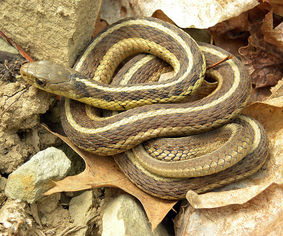Common Garter Snake

Thamnophis sirtalis
The Common Garter Snakes are commonly found across Canada from the Atlantic to the Pacific coasts. This makes them the most widely distributed North American snake. The main reason as to why they are known as garter snakes is due to their resemblance to the garter. They have patterning that resembles that of the garters. Coloration is variable but their back and the side stripes are usually dominant. The snake has side stripes which are confined to the 2nd and the 3rd scale rows. Between the stripes, there is usually a black spot often present.
The average length of the Common Garter Snake is usually between 60 and 80 centimeters. This is however the average with some of them extending up to 135 centimeters. In addition to the visible stripes on the body, the snakes also vary in color. The color ranges from green or grey to almost black. The side stripes are however never eluded. This is the key characteristic that distinct them from the rest.
The average length of the Common Garter Snake is usually between 60 and 80 centimeters. This is however the average with some of them extending up to 135 centimeters. In addition to the visible stripes on the body, the snakes also vary in color. The color ranges from green or grey to almost black. The side stripes are however never eluded. This is the key characteristic that distinct them from the rest.
The Common Garter Snake’s camouflage is its body patterning. The patterns help it to blend perfectly with the surrounding and make it easy for its hunting. Basically, the habitant of the garter snake is usually varied and irregular in color. The stripping makes the snake less visible when in the vegetation. The most common areas where one can get the Common Garter Snake are in places close to water. Their habitats are usually the wet meadows, in irrigation areas, marshes, drainage ditches, farms, parks, woodland and any place 2,450 meters above sea level. They are hence found across Canada with the exceptions of the southwest desert region.
When it comes to breeding, most of the snakes lay eggs which latter hatch. This is however not the case with the Common Garter Snake. The snake gives birth to live young ones. The breeding time is usually in the late summer when the temperature is conducive. The garter snakes have been known to give birth to around 20 and 40 babies per litter. This is however in the exception of a case recorded where the snake gave birth to a total of 98 babies.
Most of the people in the world fear snakes including the Common Garter Snake in spite of it being harmless. The garter snakes play a vital role in the garden’s ecosystem. When in the garden, the garter snake usually feeds on the frogs, earthworms and the mice. These helps in the reduction of the crop damage and in turn provide a great source of food for the mammals and the birds.
The first instinct of the Common Garter Snake when faced by a predator is to hide. When cornered, they react by bluffing. This is done by a show of temper. The garter snakes will only bite if picked up. Another form of defense is the release of a foul smelling musky liquid.
If planning on keeping the Common Garter Snake, it is advised to understand their environment and behavior. This will help in giving them the right care and avoiding the dangers that might arise.
When it comes to breeding, most of the snakes lay eggs which latter hatch. This is however not the case with the Common Garter Snake. The snake gives birth to live young ones. The breeding time is usually in the late summer when the temperature is conducive. The garter snakes have been known to give birth to around 20 and 40 babies per litter. This is however in the exception of a case recorded where the snake gave birth to a total of 98 babies.
Most of the people in the world fear snakes including the Common Garter Snake in spite of it being harmless. The garter snakes play a vital role in the garden’s ecosystem. When in the garden, the garter snake usually feeds on the frogs, earthworms and the mice. These helps in the reduction of the crop damage and in turn provide a great source of food for the mammals and the birds.
The first instinct of the Common Garter Snake when faced by a predator is to hide. When cornered, they react by bluffing. This is done by a show of temper. The garter snakes will only bite if picked up. Another form of defense is the release of a foul smelling musky liquid.
If planning on keeping the Common Garter Snake, it is advised to understand their environment and behavior. This will help in giving them the right care and avoiding the dangers that might arise.